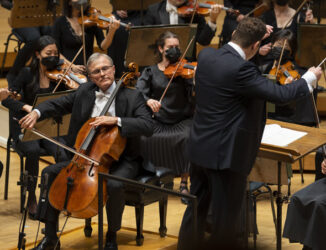John Sharp and Don Quixote: Chicago Symphony’s principal cellist returns to a classic role

‘It was intimidating and it was thrilling. That is what I remember about my first audition week’, John Sharp says, reflecting on his first moments with the Chicago Symphony Orchestra. ‘To see Solti conduct and the way the orchestra played – it was really incredibly exciting’.
Sharp, now the CSO’s principal cellist, began his musical journey far from the concert stage. Growing up in Texas, it was a stroke of luck that led him to the cello. ‘It was complete chance, really. I raised my hand’, he recalls, thinking back to his early days with the cello. ‘I was trying all kinds of things and ended up choosing the cello’. The choice propelled him on a professional journey that, starting on 24 October, will see him perform Richard Strauss’s Don Quixote with the CSO under the baton of Sir Donald Runnicles.
Despite coming from a non-musical family, by the time Sharp reached college, his future in music was firmly set in motion. Immersing himself in summer festivals, chamber ensembles and competitions, he quickly made a name for himself by winning a top prize at the renowned International Tchaikovsky Competition. In Texas, he studied under Lev Aronson, and later was a student of Lynn Harrell. Sharp’s early career saw him playing with the Metropolitan Opera Orchestra and leading the cello section of the Cincinnati Symphony.
But his career took a major leap in 1986 at the age of 27, when he was appointed principal cellist of the Chicago Symphony Orchestra, stepping into the position Frank Miller held for nearly three decades. Sharp was aware of the challenge ahead. ‘I was green really for a position like that. I knew I would have to learn on the job’. Taking on the legacy of ‘probably the most famous principal cello in America’ was no small feat, especially since, as Sharp recalls, ‘I still hadn’t played all the repertoire’.
But he had played Don Quixote which Strauss composed in 1897 as part of an ambitious series of tone poems. Strauss had taken inspiration from Miguel de Cervantes’s novel, which follows the delusional knight Don Quixote and his loyal but pragmatic squire, Sancho Panza. This narrative comes to life through Strauss’s vivid orchestration, assigning the solo cello to portray the noble yet misguided Quixote and a solo viola to represent Sancho Panza. The rest of the orchestra evokes the vivid world, from bleating sheep to tilting windmills.
As with much of Strauss’s music, Don Quixote operates on more than one level. It was conceived as a companion piece to Ein Heldenleben, and the two works form a sort of dialogue. While Ein Heldenleben celebrates the heroic spirit, Don Quixote pokes fun at the very notion of heroism. This layer of irony makes the piece both a musical retelling of a classic literary tale and a deeper commentary on the nature of heroism and human folly.
Strauss’s decision to spotlight the cello and viola gives the piece a unique quality. While the cello takes center stage as Don Quixote, leading the listener through his illusions, the viola’s grounded tone perfectly captures Sancho Panza’s more down-to-earth point of view. ‘[He] doesn’t have all these crazy dreams that Don Quixote has. He’s very practical in thinking about the problems they are about to encounter and tries to say something to Don Quixote about them’, remarks Sharp. ‘Don Quixote will have none of it. They’re going to attack the windmills’.
John Sharp’s relationship with Don Quixote began early in his career, when he performed the piece with the Cincinnati Symphony in his second year as principal, even bringing it to the storied stage of Carnegie Hall in a performance with the University of Cincinnati’s College-Conservatory of Music, replacing Zara Nelsova. ‘She became injured the day before the first concert and withdrew’ recalls Sharp. ‘They asked me if I would play it, and I was afraid to do it on one day’s notice, but I did – fortunately, I had done it a few months before’.
He has revisited the work many times as a soloist, performing it under the batons of world-renowned conductors such as Charles Dutoit and Daniel Barenboim. In 1996, Sharp recorded Don Quixote with Barenboim and the Chicago Symphony Orchestra for Teldec, an experience that further deepened his connection to the music. ‘Recording it with Barenboim was a huge thrill. That was a great honor to be able to play it with him’.
‘It’s such an interesting great piece that it never feels tiresome or boring’, Sharp reflects. ‘As you get back into it and work on it, it is just really a spectacularly written piece of music’. Each time he returns to it, Sharp finds something new to appreciate. ‘I’m always struck with what a wonderful piece it is, how inventive and descriptive it is in very specific ways, and how profound it is’.
As John Sharp prepares to partner with the Chicago Symphony through Strauss’s work, it is the emotional depth of Don Quixote’s death that resonates. ‘He’s at the end of his adventures, he has been defeated, he has been brought to his senses and realizes what a fool he’s been all this time. He is approaching death, he is old, it’s just very touching, very beautiful’. It is one of the most beautiful ‘deaths’ in all of music, with orchestra and soloist fading into oblivion, leaving the audience with the sense of having been on an extraordinary journey.
John Sharp, the Chicago Symphony and Principal Viola Teng Li will take audiences on this journey with Strauss’s Don Quixote on 24, 25 and 26 October.
Zach Carstensen
